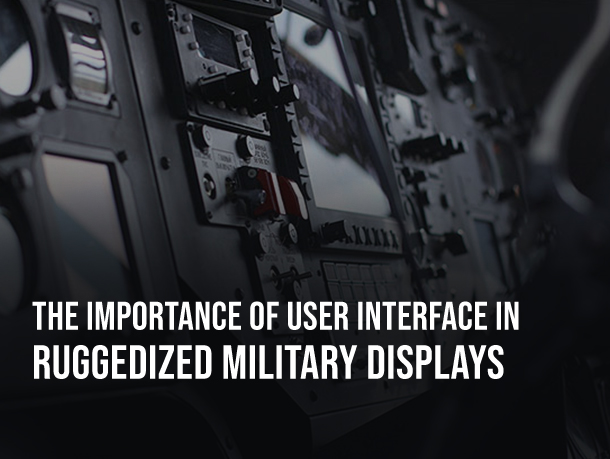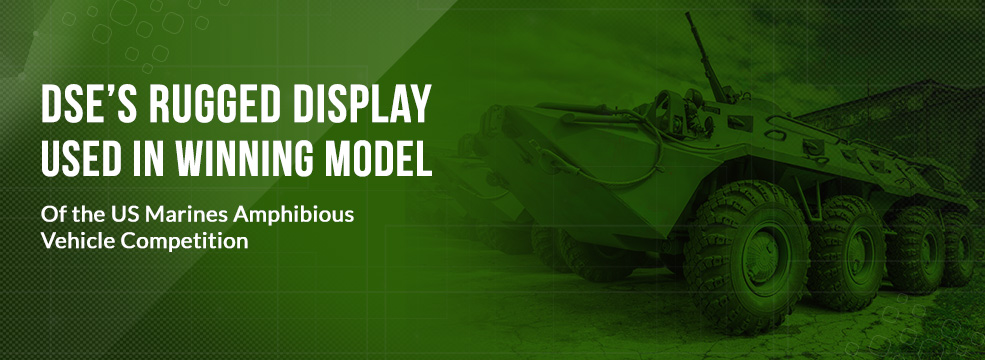The Importance of User Interface in Ruggedized Military Displays
Ruggedized Military Displays
In the search for first-rate military displays, durability and strength tend to be among the chief concerns. The display is likely to be put through extreme wear, tear and abuse, so consequently, it has to be capable of withstanding virtually anything that's thrown at it. Ruggedized displays are the answer because they are designed to endure just about anything, including severe temperatures, shock and vibration. While durability is crucial, user-friendliness matters, too. To that end, it is wise to invest in a display with a user interface designed to be intuitive, efficient and easy to navigate. In an environment where every second counts, it pays to purchase a product that won't leave users scratching their heads in the heat of the moment. Today's finest ruggedized displays include these attributes: State-of-the-Art Touch Screen Touch screens are the standard in today's electronic market, largely because they are inherently easy to use and understand. Capacitive touch screens are typically seen in the consumer market; these touch screens only work with conductive objects, such as your fingertip. Resistive touch screens provide the same benefit of allowing users to select and navigate applications quickly and easily but rely on a small amount of pressure to register the input. Resistive touch screens have higher sensor resolution, fewer inadvertent or "accidental" touches, and can register input from any object (including military gloves). Touch screens which communicate via RS232 or USB are the most versatile and will work with many different systems and applications.
Well-Designed Bezel Keys
The keys on a display should enhance the user experience ̶ not detract from it. Buttons that are too small, too difficult to press or otherwise poorly designed create major issues for users and increase the risk of making mistakes during operation. Bezel keys are angled or sloped downward around their edges, rendering them much easier to press and allowing for faster and more efficient data entry. The most advanced systems will have programmable bezel keys, giving users a customized display experience to reflect their specific needs. The recent trend to incorporate programmable bezel keys gives the user superior control of critical components such as camera and gun systems, maps, and features like image processing. These added keys allow integrators to omit additional components such as joysticks, keyboards, and pointer devices which ultimately reduces system costs, weight, power consumption and real estate demands.
Intuitive Layout
Just as certain elements on a web page are expected to be laid out in a certain way, the layout of a rugged display should follow a logical, intuitive pattern.Bezel key location, on-screen menu navigation and graphic configurability all contribute to a simple and easy-to-understand experience. Programmable graphics overlays for bezel keys allow users to customize the display by defining the specific system level control for that particular key. Each installation requires a different set of functions, and the in-field ability to program graphics overlays answers the ever-changing need. This ability can also dramatically reduce the need for training, documentation and erroneous button activation.
Night Vision Imaging Systems (NVIS) Compatibility
Those who rely on NVIS devices should select a display that is fully compatible with MIL-STD-3009. Today’s displays incorporate full brightness DAY modes, to take advantage of sunlight readable technologies, and NIGHT modes, to adapt to night vision devices without adversely affecting the performance of the critical device. Covert operations also require electronics to be equipped with a “Blackout” mode, which immediately eliminates all light transmission with the single push of a button. The most advanced systems encompass both day and night technologies to enhance performance at all times of day, for all types of missions.
Modular Design
When it comes to ruggedized military displays, one size does not fit all. Leading manufacturers understand the need for a flexible approach for easy customization and integration for all Vetronic applications. With a trend to move towards COTS designs, manufacturers leverage past experience and fielded technologies for modified products, all the while reducing lead times, NRE, and risk to quality.
Input Configurations
The most well-designed displays include a variety of inputs, allowing for use with multiple devices without the need for an adapter. Whether an HDMI, DVI, RGB, USB, RS-232, HD-SDI or another type of input is needed, users should make sure the display they buy offers a variety of options. Foremost manufacturers are beginning to include video inputs such as HDMI and Ethernet to accommodate the inevitable transition from analog to digital. Anticipating future system level requirements, customers are selecting electronics with the latest video input configurations.
Backward Compatibility
A rugged display which is both backward compatible and achieves the highest level of modernization means that legacy architectures don't have to be abandoned in order to stay on the cutting edge of technology. For land-based, aerospace or naval applications, a durable and field-proven display is a requirement, but so is one that's easy to use. Digital Systems Engineering combines rugged strength with the latest technologies to engineer solutions unmatched by any other. Contact DSE for a free engineering review and quote: (480) 515-1110
DSE’s Rugged Display Used in Winning Model of the US Marines Amphibious Vehicle Competition
In a competition by the US Marines, engineers and manufacturers participated in developing a new prototype for Assault Amphibious Vehicles, or AAVs. BAE Systems’ model won against three other manufacturers, resulting in a contract worth $103.7 million for the Engineering, Manufacturing and Development (EMD) phase of the Amphibious Combat Vehicle (ACV) 1.1 program. Digital Systems Engineering is proud to be BAE’s rugged display of choice for the winning model. DSE was chosen for their ability to modify an existing COTS (commercially available off the shelf) product quickly and cost effectively. The standard MSM212VR product was redesigned to incorporate nickel-zinc coated connectors in place of cadmium plated versions. Additionally, DSE-designed and manufactured a custom video distribution product (VH3) without impacting the program schedule.
About the Amphibious Vehicle
Assault Amphibious Vehicles (AAVs), also referred to as "Amtracks,” function as land-to-water vehicles. Fully armored, these vehicles transport marines and cargo in the most hostile territories. BAE designed an eight-wheeled vehicle, more quiet and comfortable than the previous AAV models that were fully tracked. Additionally, air conditioning and better ventilation relieve nausea previously caused by hot exhaust. The amphibious vehicle delivers substantial capability improvements that not only satisfy the Marine Corps’ current needs but also meets any future goals and potential challenges. With exceptional ground mobility and protection, the ACV solution:
- Has suspended interior seat structure for 13 embarked Marines
- Blast mitigating positions for a crew of three
- Improved survivability and force protection over currently fielded systems
- Is equipped with a new 6-cylinder and 700HP power pack, providing a significant power increase
- Weighs 63,000 pounds and has a payload capacity of 6,000 pounds
- Can reach speeds of 65 mph on paved roads, 6 knots in the open ocean
- Has a range of 350 miles or 10 nautical miles at sea followed by 200 miles on land
Feedback from vehicle operators guided the final design of the driver's instrument panel and controls that include push-button automation with a digital architecture.
About BAE Systems
BAE Systems provides some of the world’s most advanced, technology-led defense, aerospace and security solutions. BAE Systems develop, engineer, manufacture and support products and systems to deliver military capability, protect national security and people and keep critical information and infrastructure secure. With over 70 years of experience in designing and building amphibious vehicles, BAE Systems is a leading provider of combat vehicles. BAE hand-picked DSE’s rugged displays to maintain their high standard of technology, durability and efficiency in the vehicle prototype.
Digital Systems Engineering
Digital Systems Engineering (DSE) offers custom design, engineering and manufacturing of rugged mobile mil- spec and industrial flat-panel LCD displays and computers for multiple markets—primarily the military, security and industrial. Since 1995, as a privately held U.S.-owned small business (FAR 19.102), DSE has achieved a worldwide reputation for excellence in the design and manufacture of leading edge, technology-driven display and computer products. DSE is proud to be a part of BAE’s winning model of the US Marines’ Amphibious Vehicle competition.


